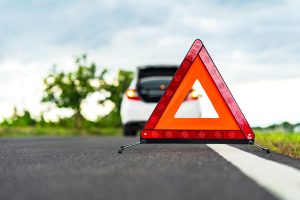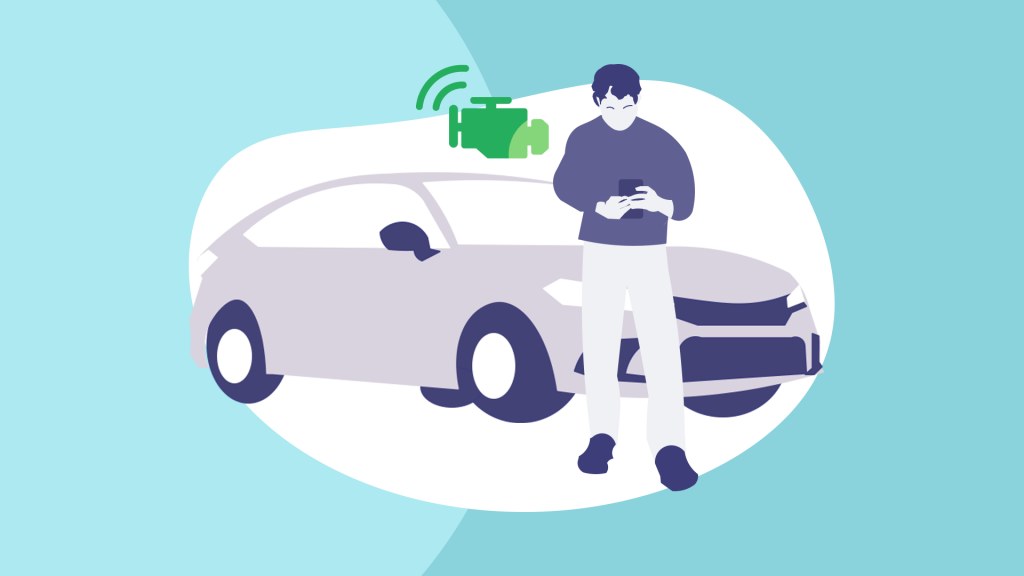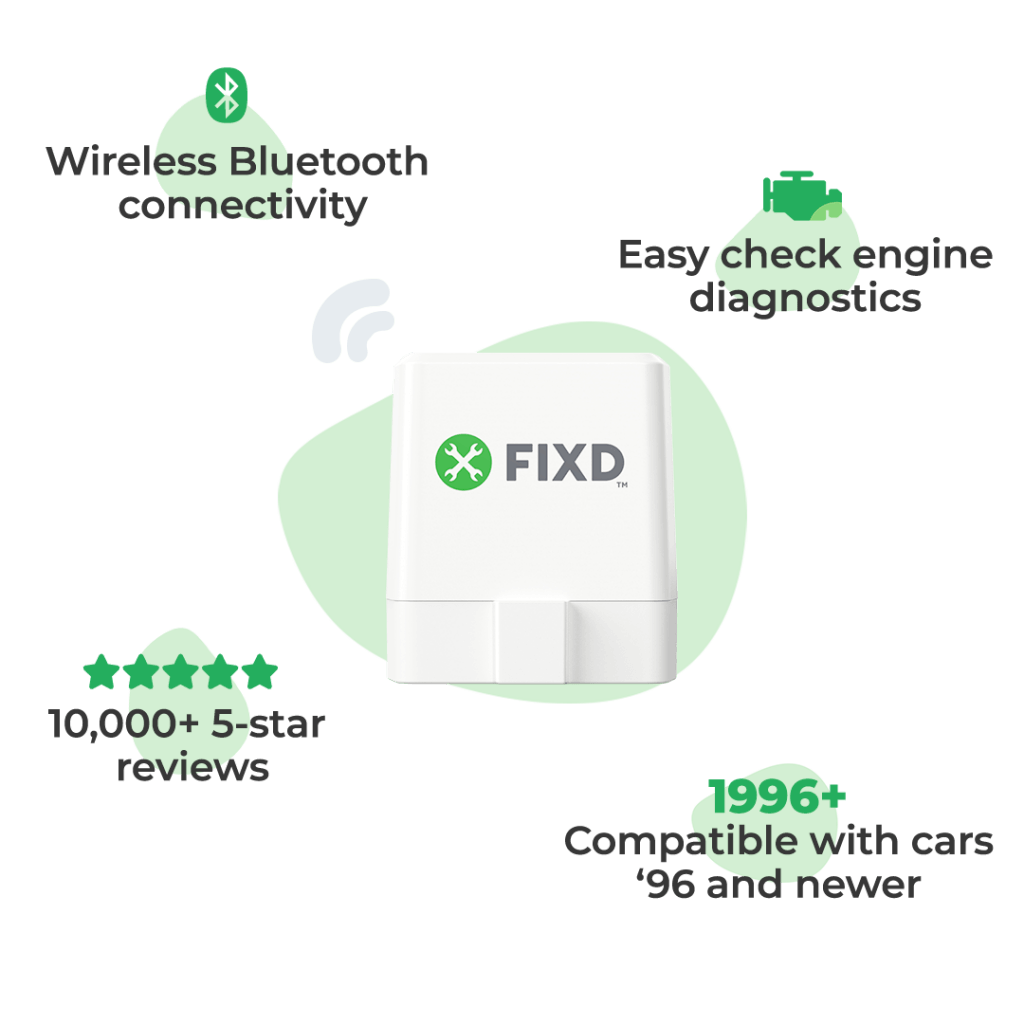Not knowing what your Check Engine Light (CEL) means or what to do when it comes on is stressful.
However, diagnosing a check engine light that comes on often centers around one of several common problems.
In this article we’ll help you identify the most likely reasons for your check engine light, the symptoms you can use to identify them, how likely it is that your car’s issue is serious, whether or not you should get a tow, and lastly, we’ll show you how to decide on DIY v.s. a mechanic for your repair.
This article will help you when handling a check engine light that just came on and it doesn’t require any special tools to use the information within. However, you should have your car scanned in order to find the diagnostic trouble code (DTC) that triggered your cars’ warning light as soon as possible. You can do this when you get your car home, to an auto parts store, or a mechanic depending on your situation and engine issue.
Plugging an OBD2 code reader into your vehicles’ on-board diagnostic (OBD) port will give you a much more definitive answer to your engine repair question (via a DTC).
Scanning your vehicle allows you to find harder-to-diagnose issues or issues that are minor now but must be fixed in order to avoid further damaging your engine.
Your vehicles’ engine is a system and one failing part can cause others to fail too.
For example, driving with a faulty O2 sensor could lead to a damaged catalytic converter. Turning what could have been $200 – $500 O2 sensor replacement into a $2000 catalytic converter replacement. Ouch.
Knowing what the real issue is can save you hundreds or even thousands of dollars between doing repairs before things get worse, and applying your knowledge of what’s wrong with your car. You can avoid paying for unneeded repairs at the mechanic easily and DIY the simple issues like a loose gas cap.
Reading your check engine light without a scanner is possible too and we cover how to do it in our article: how to read a check engine light with or without a scanner. But, it is more manual and for some issues, live data is required in order to diagnose. Live data cannot be read without a scanner or other equipment.
We also list 3 methods for reading a CEL without a scanner because not every method works on every car.
If you’d like to make your life a little easier, our scanner is only $19.99 and our app is free (just like this blog). If you want a little extra help, right now we are offering a 2 week free trial for FIXD premium, which includes our FIXD Mechanic Hotline where you can talk about your car issues and repairs 1-on-1 with a live mechanic.
Give FIXD premium a shot and if you choose to keep your subscription it’s just $5.83/month to have access to all our car related resources, including our FIXD Mechanic Hotline. Even if you don’t keep a premium subscription, our scanner is about the size of your car’s keychain remote and it fits easily in your glove compartment. You’ll be ready for unexpected engine light emergencies as long as it’s in there. And, when you need it, it will tell you what’s wrong with your car in plain English. No deciphering DTC codes necessary.
However you find your diagnostic trouble codes, you’ll be able to whittle down the possible causes much more quickly with them and be more confident in your diagnosis.
With that said, let’s dive into what to do when your check engine light comes on.
1. Pull Over and Keep Your Car On Or, Turn It Back On If It’s Off

Whether or not your car’s engine is able to run or not, take note of what your check engine light is doing. Less severe issues may cause a solid check engine light or make your light go on and off (solid when the light turns on). While serious issues like a misfire may cause your CEL to flash rapidly like your turn signal does (if it’s flashing, just get towed). This information is helpful in determining the seriousness of the issue and matching symptoms with the list of common problems in the next step.
Listening to your engine is another way to help diagnose your issue.
First, a warning: If your car is shuddering, shaking, or clearly has a misfire while driving or idling, don’t bother going any further in this article, just get your car towed. The tow will save you from making the damage much worse and increasing the cost of repairs. You have a SERIOUS issue on your hands. Sorry.
If your car’s engine is able to run without major issues like shuddering, shaking, or misfires, then listening to it may be a good way to collect clues. Listen to your engine for a little while (1-2 min). If you already turned your engine off, turn it back on to do this. Take note of any rough idling or unusual noises you might hear.
If your car is not running, you should probably only skim (or skip) “#1 Loose Gas Cap” and “#12 Check Engine Light Is On For No Reason Or Malfunctioning” in your investigation. You don’t necessarily have a serious issue but, it’s probably not the gas cap and your check engine light is definitely on for a reason.
2. Find Out If Your Check Engine Light Is Serious

While a check engine light could be bad, it doesn’t necessarily mean there is a serious issue. In fact, multiple problems that cause a check engine light can show very similar symptoms. An engine that hesitates or loses power could result from troubles with the fuel system or the catalytic converter and overheating can be caused by an issue with the cooling system or low engine oil.
In short, guessing what the problem is can lead to driving with a major issue, and that can destroy your cars’ engine. Take your time investigating possible causes, it’s worth the effort.
We will guide you through the symptoms for the common issues below and tell you how likely driving with your car’s check engine light on is to damage your engine on a short drive.
If you need to drive your car for a few days or more before fixing it, check out our article on how to read your check engine light with or without a scanner. You’ll get a more definitive answer on your problem, before you hit the road for a trip or commute. Otherwise you risk turning even minor problems into serious ones and that can get expensive.
For now, whether you have your code or not, it’s helpful to cover the symptoms of the most common reasons for a CEL just to rule out the usual suspects.
For a complete explanation of typical problems, the symptoms, the codes they trigger, and what the repair service costs are – check out the 13 Most Common Reasons For a Check Engine Light & How to Diagnose Them.
Here’s a summary of the most common symptoms for each cause/issue and whether or not you can drive with that issue. Keep your eye out for the symptoms of each of these when determining your cars’ problem:
13 Common Reasons | A Synopsis of Check Engine Light Issues:
#1 Loose Gas Cap
Having your check engine light turn on because you didn’t tighten your gas cap is practically a right of passage. Besides a CEL or warning indicator light reading “gas cap”, gas cap problems can be spotted by a noticeable gas aroma near the fuel door if the gas cap is loose or broken and can’t be tightened properly.
Driving with a loose or broken gas cap is fine, but attend to the problem as soon as possible.
#2 Spark Plugs & Spark Plug Wires
Bad spark plug(s), bad spark plug wires, or a bad spark plug coil or coils can lead to engine misfires, sluggish acceleration, and potential damage to the catalytic converter.
Spark plug-related problems can also appear as rough idling, poor fuel economy, engine knocking, or an engine that’s hard to start in cold weather or after being off for several hours. You may even notice exhaust fumes with a hint of a gasoline smell, indicating the fuel hasn’t been entirely burned in the combustion chamber.
While continuing to drive with a bad spark plug or spark plug wire won’t cause immediate damage to the car, poor acceleration or a stuttering vehicle engine can present a safety hazard. So, address the issue as soon as possible.
#3 Low Oil & Low Oil Pressure
Few car problems are as severe as low oil or low oil pressure. Ignoring a check engine light caused by low oil pressure or an engine oil warning light is the surest path to expensive repairs. Internal engine components need sufficient lubrication to operate correctly.
Cars burn (use) oil. That’s what they do, it’s natural. If your car is only burning oil make sure you regularly top off the oil and you’ll be back on the road in no time.
On the other hand, seeing a puddle of oil underneath the car or noticing a burning oil smell from the engine is a cause for alarm. Low engine oil and low oil pressure can also cause unusual engine noises and overheating. A bad oil pump, for instance, will often increase engine temperature and cause engine noise.
Unless you’re certain your car is just burning oil (not a leak or a bad oil pump etc.), pull over (where it’s safe) and turn the car off. Call a tow truck, and don’t take any chances, you can destroy your engine by driving with low oil or low oil pressure regardless of the cause.
#4 O2 (Oxygen) Sensor
Identifying a faulty oxygen sensor before there are pricey engine and catalytic converter repairs can save you a lot of money. Some faulty O2 sensors may cause your check engine light to go on and off seemingly at random (not flashing or blinking).
Symptoms to be alert for with a bad Oxygen sensor include decreased fuel economy, a rotten egg smell from the exhaust, reduced engine performance, and a failed emission test.
Your car is drivable with this issue, but don’t hold off too long on repairs. Driving with a faulty O2 sensor could lead to a damaged catalytic converter. Turning what could have been $200 – $500 Oxygen sensor replacement into a $2000 catalytic converter replacement.
#5 Catalytic Converter
Seeing a check engine light for a catalytic converter is nothing unusual, particularly in older cars, because these pollution control devices don’t last forever.
You’ll notice that the signs of a bad catalytic converter are similar to a problematic oxygen sensor: a sluggish engine, reduced mileage, a putrid exhaust smell, and polluting emissions. This should be coming as no surprise for those who know their way around an engine. These two components work hand-in-hand.
Similarly, you can operate a car with a failing catalytic converter but have the problem examined as soon as possible to avoid further engine damage.
#6 Mass Airflow Sensor
Anything that affects the proper fuel and air delivery to the engine, like a bad mass airflow (MAF) sensor, will cause engine hesitation (especially during acceleration or while the car is under a heavy load) and rough idling. You may also come across a car that’s hard to start, has a drop in fuel economy, or emits exhaust fumes with a gas smell.
It’s acceptable to drive with a MAF sensor problem. However, remember that poor acceleration and other engine performance issues can create a dangerous situation (like during highway merging or turning at an intersection).
#7 Overheating
The easiest way to kill an engine is to disregard it when it overheats.
Your car’s engine requires coolant and engine oil in order to run. Many vehicles have a separate gauge or even a warning light as a reminder that observing engine temperature is vital.
Obvious signs (besides a CEL or temperature warning light or temperature gauge) of engine overheating are steam or a burning smell from underneath the hood. Sluggish engine performance is another.
Do not ever operate a car with an overheated engine. Call a tow truck, or if the repair shop isn’t too far away, let the engine cool down and drive to the mechanic.
Topping off coolant or water if you have a leak can help you drive just a little further if you are stuck. But, never pour water into a hot engine, let it cool down first. Also, keep in mind that pure water in your engine and radiator in freezing temperatures can result in frozen water in your cooling system. Freezing water can expand as it turns into ice and cause serious damage to your car. If you add water to get home or to a shop, make sure you or the mechanic drains it before the engine gets cold.
#8 Transmission
Will a check engine light come on for a transmission problem? It depends on the vehicle. Many will have a separate indicator that alerts drivers about gearbox problems, while some use only a check engine light as a warning. Regardless of how your car is set up, always give transmission problems serious attention.
Additional indicators of a troubled transmission include a fluid leak under the vehicle, a burning smell from underneath the vehicle (which can enter the cabin), a whining or grinding noise while driving, or gear shifts that take a while to kick in (or don’t happen at all). This makes it hard for the driver to safely merge with traffic, turn at an intersection, or perform any other maneuver reliant on acceleration.
Because a weakened transmission can quickly accelerate (pun intended) into a destroyed transmission, it’s best not to drive a car with a finicky gearbox.
#9 Battery
Although not a common occurrence, seeing a check engine light on after a battery change usually means the replacement battery is bad or the power cables are loose or damaged. You’ll want to resolve this issue immediately so you don’t get stranded later.
Look for the classic red flags of a bad car battery, like an engine that’s slow to turn over or a clicking sound when turning the ignition key (and the car not starting). Flickering headlights and corroded battery terminals are other indicators.
You won’t harm a car by driving with a dying battery, but installing a new battery can easily overcome the risk of getting stranded and needing to contact a friend or a AAA-type service for a jump.
#10 Vacuum leak
Will a vacuum leak cause a check engine light to come on? Absolutely. Most times the cause of the leak is a loose or cracked hose. A leak will usually cause fuel economy to suffer, but sluggish performance and/or a sputtering engine could also result from a vacuum leak.
Vacuum leaks aren’t always easy to find or diagnose but some are. Listen for a high-pitched or whistling noise from under the hood as outside air enters the engine. Although a whistling noise alone is a good indication, if the engine also has a rough idle too, you can be pretty sure it’s a vacuum leak.
Driving with a vacuum leak isn’t a significant issue, but get things fixed when it’s possible to do so.
#11 Exhaust gas recirculation valve failure
The exhaust gas recirculation (EGR) valve is a small but essential component in today’s modern vehicles. An EGR valve may get clogged or fail, which can lead to higher nitrogen oxide emissions, reduced engine efficiency, and poor fuel economy.
The signs of a faulty EGR valve are very similar to the signs of a faulty Oxygen sensor or the catalytic converter. Engine knocking and stalling, gas-scented exhaust fumes, and a failed emissions test are all shared symptoms.
Short-term driving with a bad EGR valve is OK, but ignoring the problem can lead to replacing the catalytic converter. A bad EGR, O2 sensor or catalytic converter can be driven on but, you should get the repair as soon as possible to avoid increasing repair costs.
#12 Check Engine Light Is On For No Reason Or Malfunctioning
Can a check engine light come on for no reason? Yes, a phantom CEL is possible.
Some older vehicles may use the check engine light to tell you that it’s time for maintenance (odometer triggering). Or on other occasions, the system may get a false signal that something isn’t operating correctly (false triggering), or there could be an electrical issue (even a loose wire). Fuel with higher amounts of methanol/ethanol can also trigger a check engine light so make sure you are filling your car with gasoline that has the manufacturers recommended octane rating.
The most perplexing situation is having an illuminated CEL with no clear sign of the problem. In this situation, use your senses and best judgment. Is there any unusual sound, smell, or vibration? Does something not look or feel right? If something isn’t normal about your car (besides the CEL), calling a tow truck is usually wise. Spending time and money on a tow truck is far better than making matters worse by continuing to drive and potentially increasing the cost of your repair tenfold.
#13 Failing Aftermarket Alarm
As mentioned, electrical problems can trigger a CEL. So, can a car alarm cause a check engine light? Yes, because it involves wiring. Improper installation or poor-quality components (or both) can lead to low voltage and other electrical problems, all of which can illuminate the check engine light.
Driving with a fussy aftermarket alarm system won’t usually damage the vehicle (but may drain the battery). However, you could have to deal with problems locking and unlocking the doors, trouble starting the engine, and an alarm that goes off when there’s no security issue. It’s also best to get this fixed so you don’t develop the habit of ignoring your check engine light should a more serious issue come up.
3. Can You Drive With Your Check Engine Light On & Not Damage Your Car?
After picking through the most common reasons for a CEL and finding the culprit, you probably know the answer. But, just in case you didn’t find the culprit, keep in mind that if you drive with a check engine light on and you don’t know the cause, you are at risk of causing further damage to your engine.
Is It Safe To Drive Your Car With The Check Engine Light On?
You may wonder if it is safe to drive your car with the check engine light on. Well, it depends. You know what to do if you’ve reviewed the 13 most common reasons for a check engine light to come on (above).
Always keep in mind that flashing check engine lights are warnings of a MAJOR PROBLEM. If your check engine light starts flashing, safely pull over, turn off the vehicle, and call for a tow truck.
However, the drive or not-to-drive decision gets trickier when the cause for CEL isn’t clear (and there’s no flashing CEL). Hearing an atypical sound or noticing an unusual smell certainly indicates something is wrong. Likewise, if you encounter a strange vibration or a noticeable shaking. And as we’ve mentioned, a loss of acceleration or engine stuttering can put a car and its occupants into potentially dangerous situations (getting stuck or losing engine power on highways, interstates, and intersections).
These are all times when calling a tow truck is the best course of action. And taking this approach (by not driving) anytime there’s an unidentifiable check engine light is the only way to ensure you won’t cause further damage.
How long can you drive with the check engine light on?
If you’ve determined that the CEL isn’t severe, hitting the road is OK, but should you drive long distance with a check engine light on? No, probably not.
A minor problem can quickly become a major one over hundreds of miles. In fact, one of the first questions your mechanic will likely ask is “how long have you driven a car with your check engine light on?”. It’ll help them determine how bad the damage may be given the issue that caused your engine light to come on in the first place. In general, don’t drive long distances with your check engine light on, you are much more likely to cause a serious issue with your vehicle.
Try not to drive further than 30-50 miles. Never drive with a flashing check engine light. Stop driving if new symptoms arise.
How To Prevent Damage To Your Car If You Must Drive With A Check Engine Light On
If you decide to drive with a check engine light on, you’ll want to use a few techniques to lessen the stress on the car and reduce the chance of a significant problem arising.
#1 Reduce your speed
The faster you drive, the greater the strain on the engine (and its supporting systems like emissions and cooling). Keeping your speed in check and going more slowly can limit the damage.
#2 Limit the load
Lightening the load is another way to reduce a vehicle’s burden. This means limiting the number of passengers and removing excess weight. Don’t haul trailers or move heavy items with your vehicle if your check engine light is on.
#3 Take it easy on supporting systems
Depending on the problem, not using air conditioning or electrically operated systems like the stereo, can also help. Having the stereo off is also recommended so you can listen for engine troubles and pull over if things begin to sound worse.
Tow When Necessary
No car owner wants to deal with the time and expense of getting a car towed, but paying a small amount upfront is much better than shelling out stacks of cash for an expensive repair that could have been avoided. Just keep this suggestion in mind: if in doubt, tow.
Joining AAA (you can often sign up and get towed the same day) or another roadside assistance service can save you money, particularly if you have an older car. There are other ways to keep the cost of towing in check too.
- Explore if your insurance company offers a roadside assistance package (do this before a breakdown).
- See if you have a mobile phone service or credit card with a towing benefit.
- Use the towing services available under a new or extended car warranty.
- And, keep distance in mind. Most tow companies charge by the mile. It will often save you money to tow to the closest repair shop or dealer, just don’t get towed to a bad shop, do your research first.
The easiest way to find a trustworthy shop is with the FIXD Sensor and free app. Not only will FIXD tell you what your check engine light means and how serious it is so you know if it’s safe to drive, but it will also recommend trustworthy, RepairPal Certified shops in your area.
4. Scan Your Check Engine Light (Don’t Get Ripped Off At The Mechanic)
Heading to the mechanic with a basic idea of what’s wrong goes a long way in protecting yourself against ripoffs. You’ll want to know how to read a check engine light from your cars’ computer with an OBD2 scanner. Remember to read our extensive article on the most common reasons for a check engine light too (if you want some help matching DTC codes to common problems).
FIXD And Other OBD2 Scanners
Using FIXD or a different scanner to see what’s causing the check engine light to come on is pretty straightforward and we cover it in our article on how to read a check engine light.
If you want more support, FIXD premium subscribers can use FIXD Mechanic Hotline and talk to a mechanic for unbiased advice about repair and maintenance issues. The FIXD Sensor is only $19.99 for a limited time and includes a 2-week free trial of FIXD Premium so you can take it for a risk-free test drive.
Free Check Engine Light Testing?
There are a number of national chains (auto parts stores and mechanics shops) where you can get your check engine light scanned for free. These chains each have a website (that we list in the article) to select a location and get directions.
If you plan to go to a shop for service, you’ll want to check reviews for the shop location before you contact them or call ahead to schedule an appointment for your vehicle. Try to pick a shop that has good reviews so you can get the inspection service and the repair done all in one go, on site.
Rent An OBD2 Scanner?
The OBD2 scanners that can be borrowed for free are basic devices that read codes from your car’s computer. As discussed above, many national chains even offer a free check engine light service. You don’t even have to know how to use the scanner, they’ll do it for you. But these scanners don’t do everything.
The more experienced DIY mechanic may want a more professional device and decide to rent an OBD2 scanner at AutoZone or another auto supply store offering rentals.
An advanced OBD2 scanner rental only makes sense for someone who needs to use the device’s expanded capabilities. Most people will be just fine using a basic device.
How Do You Reset the Check Engine Light?
Here’s a step by step article on how to reset a check engine light with or without a scanner. Please check this article before you attempt resetting your engine light. It covers all methods for resetting a CEL along with the potential pitfalls and risks in full detail so you can weigh your options.
Here’s the 4 methods it covers:
- Using the FIXD app or an OBD2 reader to clear any active code from your car’s computer (codes may reappear if the problem hasn’t been corrected).
- Allowing the code to clear on its own after the repair. This can take numerous miles and/or several separate trips (some codes may still need to be cleared with a device. This method should be reserved for very minor issues like a loose gas cap).
- Turning the car on and off three times in a row (may not clear all codes).
- Disconnecting and reconnecting the battery. (This will wipe out any radio presets and seat memory positions and may require re-entering the unique radio code. In newer cars it can even cause the ECU to wipe completely, requiring a dealership to reprogram it.).
5. Decide: DIY Vs. Mechanic For The Repair

No one wants to empty their bank account for a car repair. So, those with some mechanical skills may wish to bypass the repair shop. However, the challenge comes down to determining what level of skill is required to complete a repair and whether you have it.
Replacing the spark plugs, changing a car battery, or cleaning out a clogged MAF sensor is one thing. But diagnosing and repairing low oil pressure or a complex electrical problem is something else.
A car owner needs to determine their limits when it comes to DIY fixes. Sometimes, the best-intended self-repair efforts can lead to more expensive work than if a professional mechanic handled the job to begin with. Know your limits, and don’t hesitate to seek professional advice whether you want to take a DIY approach or head straight to the mechanic.
If you want to DIY but also want some professional advice, try FIXD today for only $19.99. Your sensor includes a 2-week free trial of FIXD Premium, giving you access to our FIXD Mechanic Hotline. Our certified, unbiased mechanics can help you decide if you want to take on the repair yourself by walking you through the repair process and letting you know how difficult they think it is. If you decide to do the repair, our mechanics can help you research what parts and what gear you need. They can also help you avoid common pitfalls in the repair process too. It’s just like having a relative who is a mechanic help you out. Only you won’t get yelled at for pointing the flashlight at the wrong part of the engine.
Frequently Asked Questions: What to Do When Your Check Engine Light Comes on
What Is The Service Engine Soon Light?
The less worrisome service engine soon light is an automated reminder that your car’s engine will need maintenance or a less-severe repair or replacement soon.
Why Is My Service Engine Soon Light Blinking and My Car Shaking?
A blinking or flashing light is warning you of a serious issue. For some cars a flashing “check engine” light and in others “Service Engine Soon” light or possibly both. In any case, a flashing light is a sign to stop driving in order to prevent catastrophic and irreversible engine damage. You don’t want to wait for other symptoms like your car shaking or shuddering, that’s the swan song of your engine.
The check engine light went out by itself, but the DTC codes are still there. What should I do?
It’s not unusual for an error code to be present without an illuminated CEL. Often, this means the system hasn’t fully reset, and the car requires additional driving to complete the reset cycle. Take the vehicle to a mechanic if the code doesn’t clear on its own or the CEL comes back on.
You may also see pending codes if the fault is intermittent or the PCM requires 2 or more warm-up cycles to set the code.
If the check engine light is off, does that mean your car is fine?
A non-lit CEL means there are currently no detectable problems for the monitored systems. However, the CEL doesn’t come on or stay on for every situation and your engine may still have a problem. The best way to keep your car in optimal condition is to perform regular maintenance, watch for symptoms, check for engine codes where necessary, and take care of small engine problems before they become significant.
Does the check engine light clear itself or require manual clearing?
The CEL often goes off by itself once an issue is repaired. If the repair isn’t made or if the condition hasn’t gone away, it will come back on. Depending on the issue, several drive cycles may be needed for the light to clear. Some codes require manually resetting the car’s computer with an OBD2 reader.
Do DTC codes get stored if the CEL turns off on its own?
Yes, unless the error codes were cleared from the ECM (engine control module), they will remain in the car’s system for a mechanic to analyze.
References
- What To Do With The Check Engine Light, U.S. Environmental Protection Agency, September 2000. Retrieved March 6, 2023, from https://t.ly/Ub3a

Dave Goldberg is an automotive journalist and lifelong car fanatic. He writes for numerous enthusiast and business outlets and is an ongoing contributor to HotCars.com, one of the most popular car culture websites. When he’s not writing or driving, Dave is either under a hood or asleep. His credentials include a BA in Journalism from The George Washington University.














